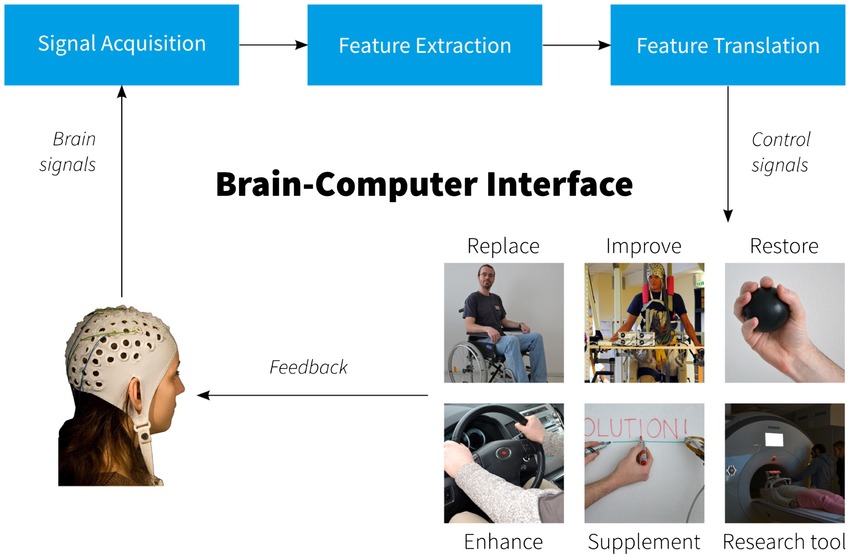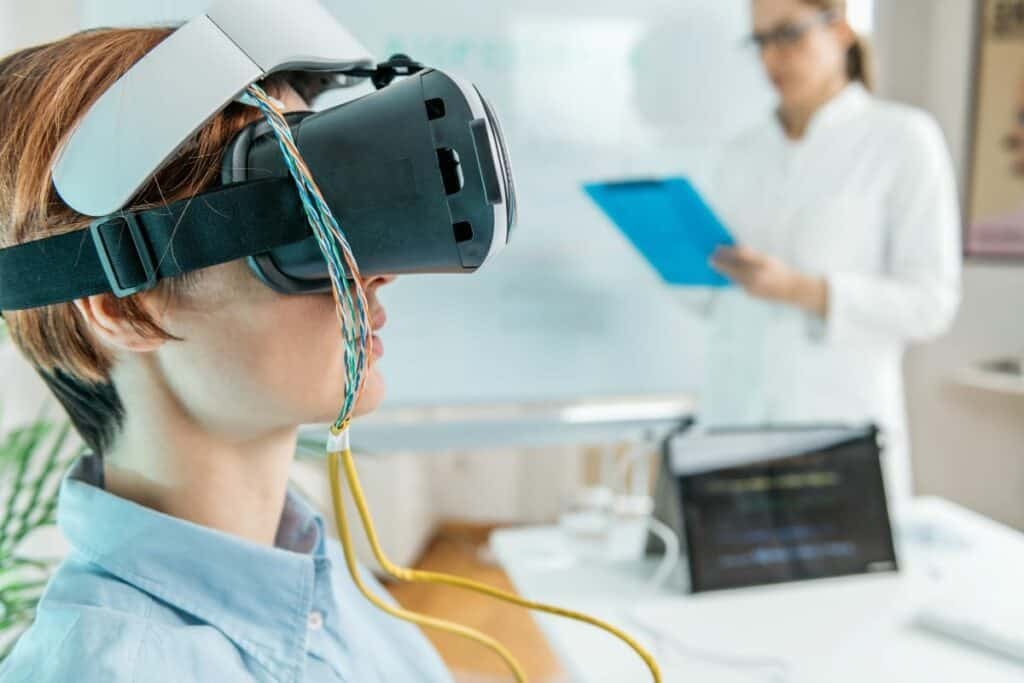
Brain-computer interfaces for accessibility: enabling communication in paralysis, etc.
“Exploring the transformative potential of brain-computer interfaces in restoring communication, mobility, and independence for individuals with paralysis and neurodegenerative conditions. This article delves into the technology behind BCIs, real-world applications, current challenges, ethical considerations, and future possibilities, highlighting how thought-controlled devices are bridging the gap between intention and action to enhance accessibility and human dignity.”
✨ Raghav Jain

Introduction
Imagine being completely locked inside your body, fully conscious yet unable to move, speak, or communicate. This state, known as locked-in syndrome or severe paralysis, has long been one of the most isolating conditions in medicine. For decades, patients had to rely on rudimentary systems like eye blinks or muscle twitches to signal yes or no answers. Today, advances in brain-computer interfaces (BCIs) offer new hope. By directly translating brain signals into digital commands, BCIs are opening pathways for communication, mobility, and independence for people with paralysis, spinal cord injuries, or neurodegenerative diseases such as ALS (Amyotrophic Lateral Sclerosis).
This article explores how brain-computer interfaces work, their applications in accessibility, the technologies behind them, current limitations, ethical concerns, and the future of this transformative field.
What Are Brain-Computer Interfaces?
A Brain-Computer Interface (BCI) is a system that establishes a direct communication channel between the brain and an external device, bypassing the body’s usual output pathways (muscles and speech organs). By recording brain activity, interpreting neural patterns, and converting them into digital signals, BCIs allow individuals to control devices or communicate with others even without physical movement.
Types of BCIs
- Invasive BCIs
- Implanted electrodes inside the brain.
- Provide high-resolution signals.
- Used in advanced clinical trials (e.g., Neuralink, BrainGate).
- Semi-invasive BCIs
- Electrodes placed on the brain surface (electrocorticography – ECoG).
- Less risky than invasive methods but still require surgery.
- Non-invasive BCIs
- Use external sensors (EEG – electroencephalography, fNIRS – functional near-infrared spectroscopy).
- Safer and widely used in research, but less accurate due to noise from the skull and skin.
BCIs for Accessibility in Paralysis
1. Enabling Communication
For individuals with paralysis, the loss of speech is often the most devastating. BCIs are restoring this capability by:
- Speller Interfaces: Patients can select letters or words on a screen by focusing on specific stimuli. For example, EEG-based systems use the P300 signal to detect when the user recognizes a target letter.
- Neural Speech Decoding: Emerging technologies translate neural activity directly into synthesized speech. In 2023, a landmark study demonstrated paralyzed patients producing sentences at near-conversational speed using implanted electrodes.
- Text-to-Speech via Brain Signals: BCIs allow patients to “think” words that appear on a screen and are then spoken aloud.
2. Restoring Mobility
BCIs are helping users control wheelchairs, robotic arms, and even exoskeletons. For people with spinal cord injuries, this provides greater independence. For instance, clinical trials have shown quadriplegic patients using brain signals to control robotic arms to drink water or feed themselves.
3. Environmental Control
BCIs enable control of smart home devices—lights, fans, TV, computers—through thought. This reduces dependency on caregivers and enhances autonomy.
4. Rehabilitation and Neurofeedback
For stroke patients or those with partial paralysis, BCIs are used in rehabilitation. By providing feedback about brain activity, BCIs encourage neural plasticity and retraining of motor functions.
Technologies Powering BCIs
- Electroencephalography (EEG)
- Most widely used non-invasive method.
- Records electrical activity from the scalp.
- Affordable and portable.
- Functional Near-Infrared Spectroscopy (fNIRS)
- Measures blood flow changes in the brain.
- Useful in detecting cognitive workload and intentions.
- Implanted Microelectrodes
- Provide precise signals directly from neurons.
- Used in cutting-edge systems like Neuralink.
- Artificial Intelligence and Machine Learning
- Neural signals are noisy and complex.
- AI algorithms decode patterns, map intentions, and improve accuracy over time.
- Wireless Transmission
- Recent advances allow untethered BCIs, making them more practical for daily use.
Current Success Stories
- BrainGate Consortium: Pioneered work in allowing paralyzed patients to control robotic arms, type on virtual keyboards, and communicate.
- Neuralink (Elon Musk’s company): Developing high-bandwidth, minimally invasive BCIs with thousands of electrodes. In 2024, Neuralink announced its first human implant trial showing promising results.
- Meta & UCSF Collaboration: Created a system that decodes speech intentions from brain signals at unprecedented speeds.
- ALS Patients: Many clinical trials now focus on giving ALS patients communication abilities after they lose the power of speech.
Challenges and Limitations
- Accuracy and Reliability
- Non-invasive BCIs suffer from signal noise.
- Invasive ones risk infection, scarring, and long-term instability.
- Training and Fatigue
- Users must often undergo weeks of training.
- Mental fatigue can degrade performance.
- Scalability and Cost
- Advanced BCI implants are expensive and not widely available.
- Insurance coverage remains limited.
- Ethical Concerns
- Privacy: Brain data is extremely personal—how should it be stored or shared?
- Consent: Patients with limited communication may struggle to give fully informed consent.
- Autonomy: Who controls the device—the patient, caregivers, or companies?
Future Prospects
The future of BCIs for accessibility is promising:
- Wireless and Wearable BCIs: EEG headbands may become as common as hearing aids.
- AI-Powered Speech Synthesis: More natural and rapid communication will be possible.
- Neural Prosthetics: Seamless integration with robotic limbs and exoskeletons.
- Mainstream Accessibility Tools: BCIs may extend beyond clinical use to help anyone with disabilities interact with digital worlds, including the metaverse.
- Ethical Frameworks: Regulations will evolve to protect brain data and patient rights.
In the vast landscape of human innovation, one of the most profound frontiers being explored today is the development of brain-computer interfaces (BCIs), especially in the context of accessibility for individuals who live with severe paralysis or conditions such as ALS, spinal cord injury, or locked-in syndrome. The ability to think a command and have it executed directly by a computer or device, bypassing the need for speech or muscle control, once belonged to the realm of science fiction, but today it is gradually becoming a reality thanks to decades of neuroscience, engineering, and artificial intelligence research. At the heart of this technology lies the principle that our brains generate measurable electrical and metabolic signals whenever we form thoughts, process sensory input, or prepare movements, and these signals can be recorded, decoded, and translated into actionable outputs through digital systems. For people whose ability to move, speak, or interact with the world has been taken away by injury or disease, this opens doors to communication, mobility, independence, and dignity in ways that traditional assistive devices could never provide. BCIs come in different forms—non-invasive systems like electroencephalography (EEG) caps that read brain waves through the scalp, semi-invasive approaches such as electrocorticography where electrodes are placed on the surface of the brain, and fully invasive methods where microelectrode arrays are implanted directly into brain tissue to capture precise neuronal firing patterns. Each has trade-offs: non-invasive BCIs are safer and easier to deploy but provide noisier, less reliable signals; invasive systems yield more accurate control but carry surgical risks such as infection, scar tissue formation, and long-term stability challenges. Regardless of method, the core function remains the same: capture brain activity, filter and decode it using advanced algorithms (often machine learning models), and convert the decoded intention into commands for an external system—whether that be typing text, generating synthesized speech, moving a robotic arm, or controlling a wheelchair. For patients who cannot speak, communication is often the most urgent need, and BCIs have made remarkable progress here. Early systems allowed patients to select letters on a virtual keyboard using specific brain responses like the P300 wave triggered when the correct letter flashed on screen, though the process was slow and effortful. More recent breakthroughs have moved toward direct neural speech decoding, where electrodes detect the brain’s motor patterns for speech articulation, and AI models reconstruct them into synthesized voice output. In 2023, researchers demonstrated nearly conversational-speed communication in a paralyzed patient using such an approach, a milestone that could fundamentally change how individuals with ALS or brainstem stroke interact with loved ones. Beyond communication, BCIs are also restoring mobility by enabling paralyzed individuals to control wheelchairs or robotic limbs purely through thought. Clinical studies have shown quadriplegic patients feeding themselves using robotic arms guided by their brain activity, while exoskeleton systems integrated with BCIs allow spinal cord injury patients to walk with assistance. Environmental control is another powerful application—users can operate televisions, computers, lights, or other smart-home devices with neural signals, reducing reliance on caregivers and restoring autonomy. Rehabilitation is an equally promising frontier: BCIs provide real-time feedback about motor imagery and brain activity, helping stroke survivors retrain damaged neural pathways and regain partial control over their bodies through neuroplasticity. All of this is made possible through a blend of neuroscience and computation. EEG remains the most accessible tool due to its portability and relatively low cost, while functional near-infrared spectroscopy (fNIRS) provides another non-invasive measure by tracking blood oxygenation changes in the brain. Invasive methods such as Utah arrays or Neuralink’s flexible polymer electrodes are at the cutting edge, capturing high-resolution signals at the level of individual neurons. The decoding challenge is immense because brain signals are noisy, dynamic, and vary across individuals, but AI and machine learning techniques now allow more accurate pattern recognition and adaptive calibration, steadily improving usability. Wireless transmission has further advanced the field, freeing patients from cumbersome laboratory setups and moving BCIs closer to everyday practicality. Real-world successes highlight the power of these systems: the BrainGate consortium has enabled patients to type, move robotic arms, and control digital devices with their thoughts; Neuralink, Elon Musk’s venture, is testing high-channel-count wireless implants that aim for scalable communication and control; research collaborations like those at UCSF and Meta have created systems that decode intended speech with unprecedented fluency; and many clinical trials are focused specifically on restoring communication for ALS patients who have lost their voices. Despite these triumphs, significant challenges remain. Accuracy and reliability still limit non-invasive devices, while invasive implants face surgical risks and durability issues. Training users to operate BCIs can be demanding, requiring mental focus that leads to fatigue. Costs are another major barrier—advanced implants and supportive technologies remain expensive, and few insurance systems currently cover them. Ethical concerns are equally critical: brain data is arguably the most private form of information a person possesses, raising urgent questions about ownership, consent, and security. For individuals with limited communication abilities, obtaining truly informed consent for experimental BCIs is complex, and there are broader societal questions about autonomy and control—who ultimately governs these systems, the patient, caregivers, or corporations that develop them? Looking ahead, the future is bright but requires careful navigation. We are likely to see wireless, wearable EEG headbands become as common as hearing aids, providing affordable non-invasive access. AI-driven speech decoding will allow natural, rapid conversation between paralyzed individuals and the world around them. Integration with prosthetics, exoskeletons, and smart-home technologies will extend independence in daily life, while regulatory frameworks will evolve to safeguard brain data, ensuring these systems empower rather than exploit vulnerable individuals. BCIs also have potential beyond disability, with possible roles in education, gaming, or even augmenting human cognition, but accessibility applications remain the most urgent and socially valuable. Ultimately, brain-computer interfaces represent not just a technological revolution but a human one—reshaping the lives of people long cut off from communication and control, and redefining what it means to connect, express, and live with dignity in the face of profound disability.
Imagine being fully conscious but unable to move, speak, or interact with the world around you, trapped in a body that refuses to respond, as happens in conditions like locked-in syndrome, severe paralysis, or advanced stages of neurodegenerative diseases such as ALS; for these individuals, the loss of communication is one of the most profound forms of isolation, and traditional assistive devices, relying on residual muscle movements or eye blinks, often offer only slow and frustrating ways to convey basic needs. Brain-computer interfaces, or BCIs, are revolutionizing this reality by creating a direct pathway between the brain and external devices, translating thought into action without the need for muscles or speech organs, and thereby restoring agency and independence to those who have been effectively silenced. At the core of BCIs is the ability to detect neural signals generated by the brain during thought, intention, or motor planning, and then decode these signals into commands that can control computers, robotic limbs, speech synthesizers, or smart home devices. BCIs can be invasive, semi-invasive, or non-invasive, each with unique trade-offs: invasive BCIs involve implanted electrodes directly in the brain and provide high-fidelity signals capable of capturing single-neuron activity, offering unparalleled control but carrying surgical risks and long-term concerns such as tissue response or infection; semi-invasive systems like electrocorticography place electrodes on the brain surface and achieve a balance of signal quality and relative safety; non-invasive approaches, including EEG and fNIRS, detect electrical activity or blood flow changes through the scalp and skull, making them safe and practical for wider use but susceptible to noise and lower signal resolution. The technology is enhanced by machine learning and artificial intelligence, which decode complex patterns in brain activity, filter out noise, and translate neural intent into actionable outputs, allowing patients to type messages, select objects, or control assistive devices with increasing speed and accuracy. For people with paralysis, communication is the most immediate application: BCIs enable typing on virtual keyboards through signals such as the P300 event-related potential, where the brain responds to recognized stimuli, or more advanced neural speech decoding, in which patterns in speech-related motor areas of the brain are reconstructed into synthesized voice output, offering near-conversational speeds as demonstrated in recent clinical trials. Beyond communication, BCIs restore mobility by enabling control over robotic arms, prosthetic limbs, wheelchairs, and exoskeletons, allowing paralyzed individuals to feed themselves, grasp objects, or even walk with assistance, greatly enhancing autonomy and quality of life. BCIs also allow environmental control, enabling users to operate lights, appliances, computers, and smart-home systems through thought alone, reducing dependency on caregivers and empowering independent living. In addition, BCIs are being used in rehabilitation: by providing real-time feedback on brain activity, they encourage neural plasticity, helping stroke survivors or partially paralyzed patients retrain motor functions and recover some voluntary movement. Several high-profile projects have demonstrated these possibilities: BrainGate has enabled paralyzed patients to type, move robotic arms, and control computers; Neuralink is developing high-channel-count wireless implants with the goal of broad clinical use; and UCSF researchers, in collaboration with technology companies, have decoded intended speech from neural activity at unprecedented levels of accuracy. Despite these advances, challenges remain significant: non-invasive BCIs are limited by signal noise and variability, invasive systems involve surgical risks and require long-term stability monitoring, user training is intensive and can lead to mental fatigue, and costs for advanced implants remain prohibitively high, with limited insurance coverage. Ethical and societal considerations are equally pressing, as brain data represents the most intimate form of personal information, raising concerns about privacy, consent, and data security; for patients who cannot communicate conventionally, providing informed consent for experimental BCIs is complex, and questions arise about who ultimately controls or has access to these technologies—the individual, caregivers, or commercial entities. Looking forward, the future of BCIs for accessibility is promising: advances in wireless and wearable devices may allow everyday use similar to hearing aids, AI-driven decoding could make communication seamless and faster, integration with robotic prosthetics and smart environments could fully restore independence, and regulatory frameworks may evolve to protect user rights and data. Beyond disability, BCIs have potential applications in enhancing cognition, gaming, or immersive digital experiences, but the most immediate and socially transformative impact is for people who have lost the ability to communicate or control their bodies. Ultimately, brain-computer interfaces are not merely a technological breakthrough; they are a profound human advancement, restoring voice and agency to individuals trapped in silence, and redefining the boundaries of interaction between mind and machine while promising a future where thought alone can bridge the gap between intention and action, offering millions of people the dignity, independence, and connection that were once thought impossible.
Conclusion
Brain-computer interfaces are revolutionizing accessibility for individuals with paralysis and related conditions. From enabling basic communication to restoring mobility and autonomy, BCIs are bridging the gap between thought and action. Although challenges such as cost, accuracy, invasiveness, and ethics remain, progress is rapid. Future generations of BCIs promise faster, safer, and more user-friendly systems that will empower millions of people worldwide.
At its core, BCI technology is not only a scientific breakthrough but also a profound step toward human dignity—restoring the most fundamental ability to connect, express, and live independently.
Q&A Section
Q1:- What is a Brain-Computer Interface (BCI)?
Ans:- A BCI is a system that allows direct communication between the brain and external devices, bypassing muscles or speech organs, enabling users to control computers, prosthetics, or communication systems using only their brain activity.
Q2:- How do BCIs help people with paralysis?
Ans:- BCIs enable communication by translating brain signals into text or speech, allow control of wheelchairs or robotic arms, and provide access to smart home devices, giving independence to individuals with paralysis.
Q3:- What are the main types of BCIs?
Ans:- The three types are: invasive (implanted electrodes), semi-invasive (on the brain surface), and non-invasive (external sensors like EEG).
Q4:- What are some real-world examples of BCIs in use?
Ans:- BrainGate has enabled quadriplegic patients to move robotic arms, Neuralink is testing implants for communication, and research teams at UCSF have enabled near-conversational speech from brain signals.
Q5:- What challenges do BCIs face today?
Ans:- Challenges include limited accuracy in non-invasive devices, surgical risks in invasive ones, high costs, long training times, mental fatigue, and ethical issues related to brain data privacy.
Similar Articles
Find more relatable content in similar Articles

3D-Printed Organs: Are We Clos..
3D-printed organs are at the f.. Read More

The Future of Electric Planes ..
The aviation industry is under.. Read More

Virtual Reality Therapy: Heali..
Virtual Reality Therapy (VRT) .. Read More

E-Waste Crisis: The Race to Bu..
The rapid growth of electronic.. Read More
Explore Other Categories
Explore many different categories of articles ranging from Gadgets to Security
Smart Devices, Gear & Innovations
Discover in-depth reviews, hands-on experiences, and expert insights on the newest gadgets—from smartphones to smartwatches, headphones, wearables, and everything in between. Stay ahead with the latest in tech gear
Apps That Power Your World
Explore essential mobile and desktop applications across all platforms. From productivity boosters to creative tools, we cover updates, recommendations, and how-tos to make your digital life easier and more efficient.
Tomorrow's Technology, Today's Insights
Dive into the world of emerging technologies, AI breakthroughs, space tech, robotics, and innovations shaping the future. Stay informed on what's next in the evolution of science and technology.
Protecting You in a Digital Age
Learn how to secure your data, protect your privacy, and understand the latest in online threats. We break down complex cybersecurity topics into practical advice for everyday users and professionals alike.
© 2025 Copyrights by rTechnology. All Rights Reserved.